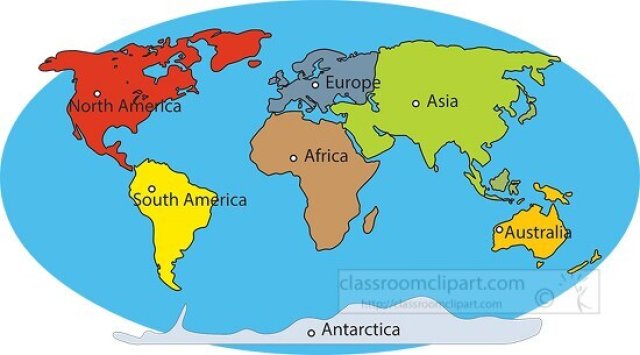The Seven Continents of the World
Learn about the seven continents of the world—Asia, Africa, North America, South America, Antarctica, Europe, and Australia. Discover key facts, maps, cultures, and geography in this student-friendly article

Introduction
Have you ever looked at a map or globe and wondered why the Earth's land is divided into big sections? These large pieces of land are called continents. A continent is a huge landmass that is usually separated from others by oceans or natural boundaries. There are seven continents on Earth: Africa, Antarctica, Asia, Australia, Europe, North America, and South America. Each one is different in size, climate, landscape, people, and animals.
In this article, you'll learn what a continent is, where each one is located, and what makes each one unique. Whether you're studying for a test or just curious about the world, this guide will help you understand how our planet is organized.
🌐 What Is a Continent?
A continent is one of Earth's largest land areas. Continents are not just big islands-they are entire regions that include mountains, rivers, forests, deserts, cities, and much more. Scientists and geographers group Earth's land into seven main continents to make it easier to study geography, cultures, and ecosystems.
Most continents are made up of many countries, each with its own borders, government, and people. While some continents are joined together by land (like Europe and Asia), others are surrounded completely by water.
🌍 Meet the Seven Continents
Each of the seven continents has something special to offer. Some are full of people and cities. Others are quiet and wild. Here is a closer look at each one:
1. Africa
Africa is the second-largest continent and is believed to be the birthplace of humanity. It has 54 countries-the most of any continent-and is home to over 1.4 billion people. Africa has deserts like the Sahara, jungles like the Congo Rainforest, and long rivers like the Nile, the longest river in the world. Wildlife such as lions, elephants, and giraffes roam freely in parts of Africa.
2. Antarctica
Antarctica is the coldest, driest, and windiest continent. It's located at the South Pole and is covered in ice all year round. There are no permanent residents, but scientists from many countries live there for part of the year to study its unique climate and animals like penguins, seals, and whales.
3. Asia
Asia is the largest continent by both size and population. Over 4.7 billion people live here-more than half of all the people in the world! Asia includes countries like China, India, Japan, and Russia. It has many natural wonders, including the Himalayas (home to Mount Everest, the tallest mountain in the world) and the Gobi Desert. Asia also has a rich history, including the Great Wall of China and ancient temples.
4. Australia
Australia is both a continent and a country. It's the smallest continent and part of a region known as Oceania, which includes nearby islands like New Zealand and Papua New Guinea. Australia is known for its unique animals like kangaroos, koalas, and the platypus. It's also home to the Great Barrier Reef, the world's largest coral reef.
5. Europe
Europe is famous for its history, art, and landmarks like the Eiffel Tower in France and the Colosseum in Italy. Though it's the second-smallest continent, it has a big impact on the world. Europe has about 750 million people living in countries like Germany, Spain, and Greece. Many important events in world history, such as the Renaissance and World Wars, happened here.
6. North America
North America includes countries like the United States, Canada, and Mexico. It has many different types of land-from icy tundras in the north to tropical beaches in the south. North America is known for landmarks like the Grand Canyon, the Rocky Mountains, and the Great Lakes. About 600 million people live on this continent.
7. South America
South America is home to the Amazon Rainforest, the largest rainforest in the world, and the Andes Mountains, the longest mountain range. Countries here include Brazil, Argentina, and Peru. South America has many Indigenous cultures and a wide range of plants and animals, like jaguars, sloths, and colorful birds called macaws.
📍 Where Are the Continents Located?
Each continent has a specific place on the globe:
-
Asia is mainly in the Northern and Eastern Hemispheres.
-
Africa crosses both the equator and the prime meridian.
-
North and South America are in the Western Hemisphere.
-
Europe is just west of Asia and north of Africa.
-
Australia is in the Southern Hemisphere.
-
Antarctica is all the way at the South Pole.
(Insert colorful labeled world map here with each continent clearly marked)
📊 Comparing the Continents
Here's a simple chart to compare some key features:
| Continent | Area (km²) | Population | Fun Fact |
|---|---|---|---|
| Asia | 44.6M | 4.7 billion | Home to Mount Everest |
| Africa | 30.3M | 1.4 billion | Has more countries than any other |
| North America | 24.7M | 600 million | Home to the Great Lakes |
| South America | 17.8M | 430 million | Home to the Amazon River and rainforest |
| Antarctica | 14M | 0 | Covered in ice, with no cities |
| Europe | 10.2M | 750 million | Birthplace of many major world events |
| Australia | 8.6M | 44 million | Famous for marsupials like kangaroos |
💡 Fun Facts About the Continents
-
Asia has the most people and the tallest mountain.
-
Africa has the most countries and the longest river.
-
Antarctica is the only continent with no permanent human population.
-
Australia has animals that live nowhere else in the world.
-
Europe is home to more than 200 languages.
-
North America includes the world's third-largest country-the United States.
-
South America has the world's highest waterfall-Angel Falls in Venezuela.
👧🧒 Kid-Friendly Summary
There are seven continents on Earth, and each one is special in its own way. Some, like Asia and Africa, are huge and full of people, animals, and amazing places. Others, like Antarctica, are cold and empty except for a few scientists. Learning about continents helps you see how big and wonderful our world really is. From the snowy South Pole to the hot deserts of Africa, every continent has something exciting to discover!
🧠 Interactive Quiz: How Well Do You Know the Continents?
1. Which continent is the largest in both size and population?
A) Africa
B) Asia
C) North America
D) Europe
2. Which continent has no permanent residents?
A) Europe
B) Australia
C) Antarctica
D) South America
3. Which continent includes the country of Brazil?
A) Africa
B) Asia
C) South America
D) North America
4. Which continent is also a country?
A) Asia
B) Europe
C) Australia
D) Antarctica
5. What is the name of the world's longest river, located in Africa?
A) Amazon
B) Nile
C) Mississippi
D) Yangtze
-------------------------------------


















































